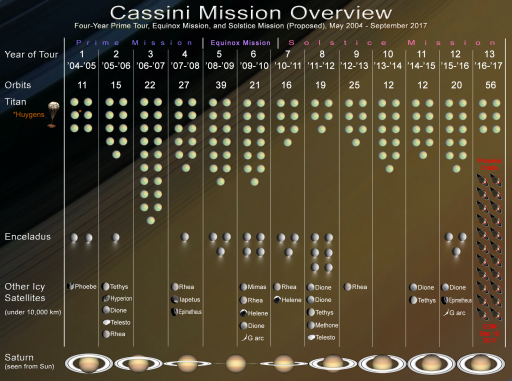Emily Lakdawalla • Mar 04, 2009
Update to my S/2008 S1 post: Cassini can fly past it!
UPDATE: This new moon is now named Aegaeon.
So it turns out I was totally wrong yesterday when I claimed that Cassini wouldn't be allowed to get close enough to the G ring to get a decent image of the newly discovered tiny moonlet S/2008 S1. And actually the clue was sitting right in front of me in the form of that "Cassini Mission Overview" slide I posted last week. Check out the "other icy satellites" row for year 6 and year 12 of the tour:
Yes, the G ring is "dusty and extended", but the core of the ring, where the arc and this parent body lives, is only about 500 km wide radially and 500 km thick vertically. (The full ring is more like 11,000 km radial extent by 1,000 km vertical extent.)So we could get quite close to it. Flying over or under it in an orbit with a small inclination would allow us to image S/2008 S1 quite safely in theory. And don't forget, both Pioneer 11 and Voyager 2 flew directly through the extended G ring (Voyager 2 through the "core"). Cassini has clipped the edges of the extended G ring region a number of times already, and will several more times in the coming years (it is, after all, one of the objects of interest to scientists). But you are correct in that we very specifically avoid flying through or very near to the core region, especially near this bright arc and parent body.
Support our core enterprises
Your support powers our mission to explore worlds, find life, and defend Earth. You make all the difference when you make a gift. Give today!
Donate

 Explore Worlds
Explore Worlds Find Life
Find Life Defend Earth
Defend Earth


